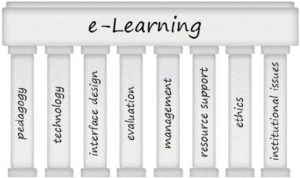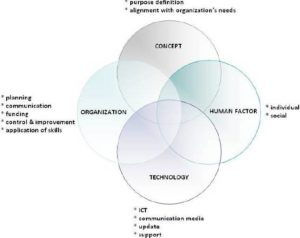- An organization should evaluate the actual need to implement the e-Learning program and its justification (potential to increase performance, cost efficiency, future benefits, etc.). An organization should conduct a detailed study of its vision, objective, and learning needs and how e-Learning can fulfill these needs. Next, it should select the suitable e-Learning program. An e-Learning system management team should be appointed, with responsibility for proper planning, design and control of the system implementation.
- Implementation of e-Learning programs should be funded adequately. A separate budget should be designed for planning, design, support, and management of the implementation.
- The selected technical equipment, hardware and software tools as well content-based design should match the needs of the organization and its employees. Hardware, software, and the course content for the e-Learning system should be selected carefully, according to the strategic e-Learning implementation plan, with the use of the assigned budget. The course content should be designed by experts who should be informed of the e-Learning purpose and requirements in detail.
- All the competent staff members should be involved in the preparation of the training program. They should communicate with each other actively and on regular basis – before, during, and after implementation of the e-Learning process. Arising problems and issues should be communicated in timely manner in order to find right solutions and incorporate them in the implementation process.
- Installation of the system should be conducted in a time-efficient manner. The preparation process should include a project plan with a detailed schedule of all the steps of the implementation, with enough time allocated to each step, taking into consideration potential difficulties and delays.
- The training program should be explained and promoted properly to all the stakeholders, i.e. managers, implementation team members, IT staff, employees (end users), etc. Proper and timely presentation (marketing) of the e-Learning system’s purpose and value (both for individual employees and for the organization as a whole) can motivate the stakeholders and eliminate potential refusal to participate as the reviewed research outcomes suggest.
- Sufficient time and work conditions should be provided to the end users of the e-Learning training program. According to the reviewed literature, e-Learning programs do not serve their purpose if they are not incorporated efficiently in the workload of learners (the organization’s employees) and if the learners do not have time to participate in e-Learning training.
- Technical support and service should be available at all times. The actual creation and installation of an e-Learning system is not sufficient to achieve successful learning. Many technical, logistical and organizational issues may come up during the whole process of using the system. Therefore, it is necessary to provide constant technical help and service if problems emerge. Responsible staff should be appointed to provide assistance.
- Regular evaluation of the training program and of its organizational and technical aspects should be conducted. Feedback from all the stakeholders and lessons learned should be collected and incorporated in the improvement process. A responsible team should be appointed that will conduct this formal evaluation via performance analysis, statistical data, questionnaires, reports from the technical support staff, etc.
Conclusions
Implementation of e-Learning has its important place in business. It is an on-going process. As such, it does not start and end with the actual technical installation and providing the training courses. The outcomes and lessons learned should be constantly used to improve and innovate the whole system for better future utilisation. At this point, it is hard to say which of the e-Learning barriers is predominant. The correct understanding of the concept of e-Learning is essential and all other processes stem from its definition in a particular organization in the first place. However, each component (conceptual, organizational, technical, and human) influences the others significantly. Further study is needed in this area to find out how exactly these components are interconnected and especially how the human factor impacts success of e-Learning in an organization. Case studies and practical examples of e-Learning implementation may bring more light on these issues.
Acknowledgment
This paper was created with the support of the ESF project INDOP — Innovation and Support of the Doctoral Study Program, identification number CZ.1.07/2.2.00/28.0327.
References
Bureš, V. & ÄŒech, P. (2007). ‘Knowledge Intensity of Organizations in Knowledge Economy,’ Proceedings of the 3rd International Conference on Web Information Systems and Technologies, Barcelona, Spain, 210-213.
ÄŒech, P. & Bureš, V. (2009). “Advanced Technologies in e-Tourism,“ 9th WSEAS International Conference on Applied Computer Science, Genova, Italy, 85-92.
Publisher – Google Scholar
Cedefop (2001). E-learning and Training in Europe, Cedefop Reference Series, Office for Official Publications of the European Communities, Luxembourg.
Publisher
ÄŒerná, M. & Poulová, P. (2008). ‘Visit Rate of Internet Portals and Utilization of Their Tools and Services,’ E+M Ekonomie a Management, 11 (4), 132-143.
Google Scholar
Clarke, A. (2008). E-Learning Skills, Palgrave Macmillan, New York.
Publisher – Google Scholar
Deall, W. F. (2002). “Distance Learning: Teaching Technology Online,“ The Technology Teacher, May/June, 21-26.
Publisher – Google Scholar
Finley, D. L. (2000). “Online Education as a Means for Workplace Learning: A Case Study,“ Annual Meeting of the American Educational Research Association, New Orleans, LS, 1-7.
Publisher – Google Scholar
Khan, B. (2012). E-learning Framework. [Online], [Retrieved April 20, 2012], http://asianvu.com/bk/framework/.
Publisher
Mikulecký, P. & Mikulecká, J. (1999). “Active Tools for Better Knowledge Dissemination,“ Proceedings of the 62nd ASIS Annual Meeting, Washington, D.C., 420-427.
Publisher – Google Scholar – British Library Direct
Mohelská, H. (2009). ‘Value of ICT Mobile Means in an Increase of Company Competitiveness,’ World Multiconference on Applied Economics, Business and Development, Tenerife, Spain, 137-140.
Google Scholar
Moses, K. D. (2001). ‘The Role of e-Learning in Training and Development,’ TechKnowLogia, 3 (3), 13-14.
Google Scholar
Newton, D. & Ellis, A. (2005). “Effective Implementation of e-Learning: A Case Study of the Australian Army,” Southern Cross University ePublications@SCU. [Online], [Retrieved January 28, 2012], http://epubs.scu.edu.au/tlc_pubs/l/.
Publisher – Google Scholar – British Library Direct
Schreurs, J., Sammour, G. & Ehlers, U. (2008). “ERA — E-learning Readiness Analysis: An eHealth Case Study of e-Learning Readiness,” Lytras, M. D., Carroll, J. M., Damiani, E., Tennyson, R. D., Avison, D., Vossen, G. and Ordóñez de Pablos, P. (eds), The open knowledge society. A Computer Science and Information System Manifesto, Springer-Verlag, Heidelberg, 267-275.
Publisher – Google Scholar
Stephenson, J. (2003). “A Review of Research and Practice in e-Learning in the Workplace and Proposals for Its Effective Use,“ Annual Meeting of the American Educational Research Association, Chicago, IL, 21-25.
Publisher – Google Scholar
Weaver, P. (2002). “Preventing e-Learning Failures: Ten Common Pitfalls and How to Avoid Them,” American Society for Training and Development. [Online], [Retrieved January 28, 2012],http://findarticles.com/p/articles/mi_m0MNT/is_8_56/ai_90512523/?tag=content;col1.
Publisher
Whiteman, J. A. M. (2001). “Relevance of Education & Training in a Business Environment,”. [Online], [Retrieved January 28, 2012], http://www.eric.ed.gov/PDFS/ED455419.pdf
Publisher




